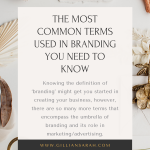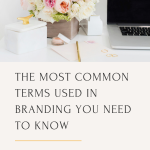
The Most Common Terms Used in Branding You Need to Know
Table of Contents
ToggleSharing is caring!
Reading Time: 2 minutes


Branding itself is a hugely broad term that encompasses many smaller heads. To succeed in the universe of branding, you need to know these most common terms.
Knowing the definition of ‘branding’ might get you started in creating your business. However, there are so many more terms that encompass the umbrella of branding and its role in marketing/advertising.
Here are the most common terms used in branding and why you need to know them:
Asset
Your brand assets are the physical images that belong solely to your brand. Like the golden arches are a signature asset of McDonald’s, your logo, and the words and pictures you uniquely create for your brand become your assets. It is essential to make sure your assets are polished, are in a variety of file types (.jpeg and .png), and easy to access by your team.
Branding
In case you’re still not sure what branding means, here’s a general definition. A business can create a name, image, and other distinguishable parts that will set itself apart from the competition and give it a recognizable edge within the market. It’s what differentiates one brand from another.
Brand Equity
Probably one of the most recognizable brands in the world, Apple has accumulated incomparable brand equity. Your brand equity is the measure of how recognizable your brand has become and how much power it has within the market. As your brand grows and builds trust and loyalty, you’ll be able to see how much equity or “goodwill” you’ve accomplished.
Brand Identity
This word is widely used when the topic of branding is discussed. A brand identity is, like your own, what makes you unique, what others see when they look at you, and what makes up your individuality at the core of your brand. It’s your logo, your colours, your fonts, and even the overall emotion and personality that your brand delivers.
Brand Loyalty
Imagine having customers that felt that they couldn’t survive without your brand. It may seem a little far fetched, but there are thousands of brands that have fully absorbed their customers and audience right into their brand. They’ve proved beyond a doubt that they are superior to the competition. If you’re brand strategy and identity, and, of course, your product and customer experience all line-up, there’s no reason why you wouldn’t begin to grow your brand loyalty.
Brand Positioning
Your brand positioning is how you position, thus the name, yourself within the market to stand out among your competition. Why is it that your target audience should choose you over another brand? What benefit do you provide? Offering a product itself is often not enough, there needs to be a fighting contributor that, when presented to your audience, will spark that purchase.
Strategy
What is your brand strategy? It’s how you, your marketing team, your employees, and even your graphic designer, create your brand, plan ideas and methods of presenting your product/service to your customers, and how you’ll reach your audience. You can’t make a brand and expect it suddenly to be successful on its own; you’ve got to have an excellent, robust strategy.
There are so many other terms that fall under the broader spectrum of branding. If you have any further questions or need help in creating your own brand strategy, reach out for a conversation with a member of our team today.
Most Popular Posts:
Sharing is caring!
PLEASE COMMENT BELOW